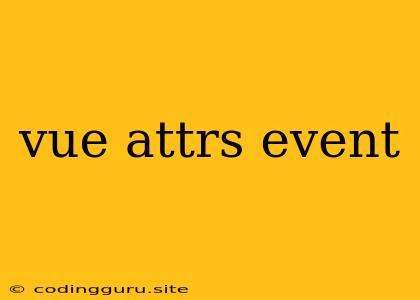Understanding and Utilizing attrs and events in Vue.js
Vue.js is a progressive JavaScript framework designed to build user interfaces. One of its key features is component-based architecture, allowing developers to break down complex applications into smaller, reusable parts. When building these components, you often encounter scenarios where you need to pass data and handle events from parent components. This is where the attrs and events properties come into play.
What are attrs and events in Vue.js?
In essence, attrs and events are special properties that allow components to access attributes and events from their parent components.
attrs: This property holds all the attributes passed down from the parent component, excluding those explicitly declared in the component's props. This means it provides a way to access any other attributes that are not directly managed through props.
events: This property, on the other hand, gives you a way to access events emitted by the parent component. This provides a mechanism for child components to listen and react to events triggered in the parent component.
When and Why Use attrs and events?
Let's explore some common scenarios where these properties prove valuable:
1. Passing Attributes to Nested Components: Imagine a scenario where you have a parent component with a complex structure, containing nested child components. You might want to apply specific styles or classes to these nested elements without having to define them explicitly in each child component. attrs allows you to pass these attributes down to the nested components, making your code more organized and maintainable.
2. Handling Events from the Parent Component: Imagine a scenario where a parent component is responsible for managing a certain action, such as deleting an item. However, the actual deletion logic might be implemented in a child component. Using the events property, the child component can listen for events emitted by the parent component, such as a "delete" event, and perform the necessary actions.
3. Creating Generic Components: When building reusable components, you often want them to be flexible and adaptable to various contexts. attrs and events help achieve this flexibility by allowing components to receive dynamic information from the parent component. For example, you could create a generic button component that receives its text, color, and click handler through attrs and events, allowing it to be used in different scenarios without modification.
4. Building Complex User Interfaces: In complex applications, user interactions often involve multiple components working together. events provide a powerful mechanism for coordinating these interactions. Imagine a form where a user needs to select a date from a calendar and then submit the form. The calendar component could emit an event with the selected date, which the form component could listen to and update its internal state.
Example: Using attrs and events to Build a Reusable Button
In this example, the MyButton component receives a label prop, along with any other attributes and styles passed down through attrs. The onClick method emits a "click" event, which the parent component can listen to and handle appropriately.
Tips for Using attrs and events
-
Inheritance: You can control whether a component inherits attributes using the
inheritAttrsoption. If set tofalse, the component will not inherit attributes from its parent component. This can be useful for preventing conflicts or unwanted behavior. -
Event Handling: Remember that the
eventsproperty is an object, and its keys are the names of the events that the child component listens to. You can use methods or functions to handle these events in the child component. -
Scoped Slots: While
eventsare useful for communicating between components, scoped slots can be more efficient and flexible when dealing with data passing and event handling within a component's template.
Conclusion
attrs and events offer powerful mechanisms for building robust and flexible components in Vue.js. By understanding their purpose and using them effectively, you can create reusable and maintainable components that effectively manage data flow and communication within your application. Remember to choose the appropriate strategy for each scenario, considering the complexity of your application and your overall design goals.
